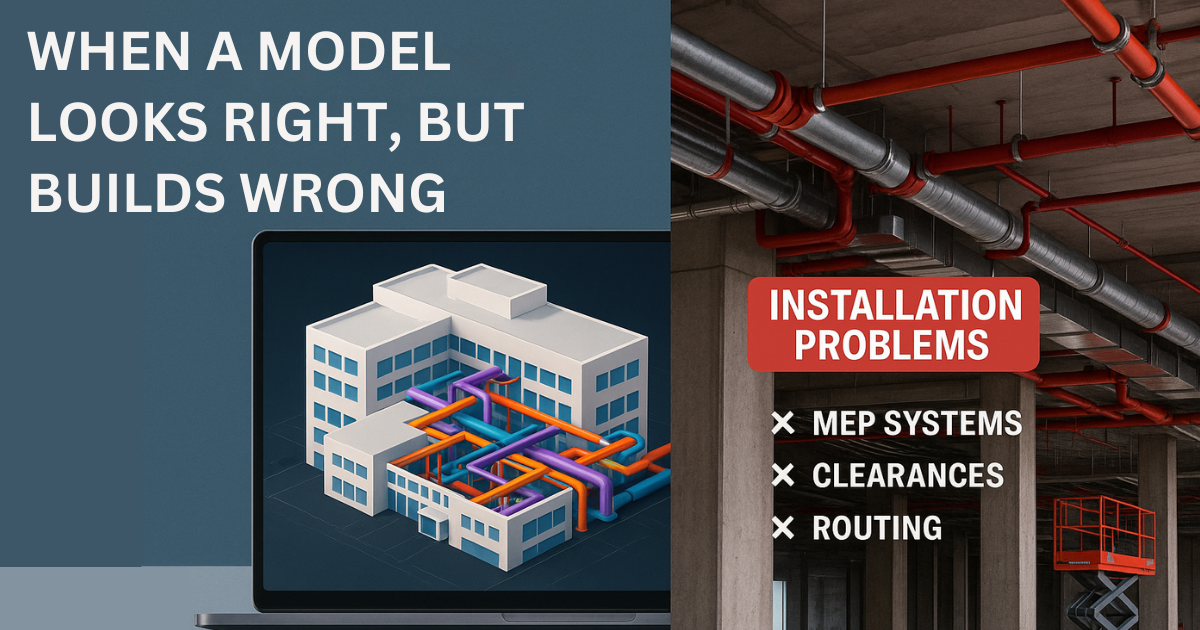When a model looks right, but builds wrong
The hospital project seemed ready. Tight timeline. Experienced team. BIM files delivered on time. Everything looked greenlit—until construction hit week 18.
That’s when reality hit harder.
The MEP systems didn’t fit. Not by inches. By feet. Clearances? Skipped. Routing conflicts? Missed. Structural interferences? Ignored.
The “good enough” model had passed all compliance checks—but failed in the field.
This isn’t a failure of people. It’s a failure of process.
Because when BIM is treated as a checkbox instead of a strategy, the price isn’t just technical—it’s operational, financial, and reputational.
From chaos to clarity
Every construction project is a moving system of parts. Designers, engineers, contractors, superintendents, clients. Each with their own expectations and timelines. All pushing for progress.
But without real coordination, nothing moves forward. What grows instead is chaos. Misalignment. Delays.
The mistakes that—if not caught early—turn into the real cost of skipping BIM strategy.
BIM well-applied is not about deliverables
It’s about using information, technology, and expertise to anticipate. To solve problems before they hit the field. To design from construction logic, not just from behind a desk.
Real coordination isn’t about filling spreadsheets. It’s about making sure every stakeholder speaks the same language, at the same time, toward the same goal.
At BSPK, we lead the full BIM process—not just the modeling, but the thinking behind it. Because we know where “just good enough” really takes you:
Design changes caught during VDC coordination are 8x more efficient than those made in the field. One fix in the model avoids labor stoppage, subcontractor remobilization, wasted material, schedule delays, and costly ping-pong between subs, GCs, owners, and designers.
Let it slide, and you’re not just spending 8x more—you’re buying demolition, logistics chaos, and a hospital that can’t open on time. No patients, no income, no ROI.
Miss one trade window and you disrupt every team downstream. Miss a weather window, and you’re now building against the forecast. The result? Pushed dates. Delayed operations. Lost trust.
When models aren’t grounded in real-world install logic, engineers second-guess details, field teams double-handle work, and superintendents stop relying on BIM. Confidence erodes. Momentum stalls.
It’s not about software. It’s about focus
There are hundreds of tools. But few teams that truly understand what to do with them.
At BSPK, we don’t use BIM as the goal. We use it as a bridge—between design and construction, between intention and execution, between teams that don’t always speak the same technical language.
What we prevent isn’t just a mistake. It’s the domino effect that mistake can trigger.
How we work
We start from the project’s reality, not a generic template. We tailor workflows to fit the client’s logic. We automate repetitive tasks to unlock strategic time. We coordinate from design to operations. We prevent instead of react.
The difference isn’t in having prettier models. It’s in making faster, clearer, and more aligned decisions.
Because building well starts long before the first brick is laid.
The audit question
- Does your project have a real coordination strategy?
- Are your models anticipating or just documenting?
- Are you using BIM to connect your teams—or just to comply with requirements?
- Is your project guided by data or lost in disconnected drawings?
If your BIM team focuses more on formats than field logic… If you’re still relying on PDFs and verbal RFIs… If your model looks good in review but breaks trust in the field…
Then you’re paying for modeling—not for construction-readiness.
The alternative
Precision isn’t expensive. Imprecision is.
At BSPK, we guide every part of the process—from strategy and BXP to modeling, coordination, and field-true documentation. Because buildings aren’t built on screens. They’re built for people.
Independence isn’t doing everything alone. It’s having the freedom to prevent problems before they start. To coordinate with confidence. To build with intent, not just compliance.
That’s what we do every day. We Know BIM Better.
And we’ll prove it—one clash-free floor at a time.



